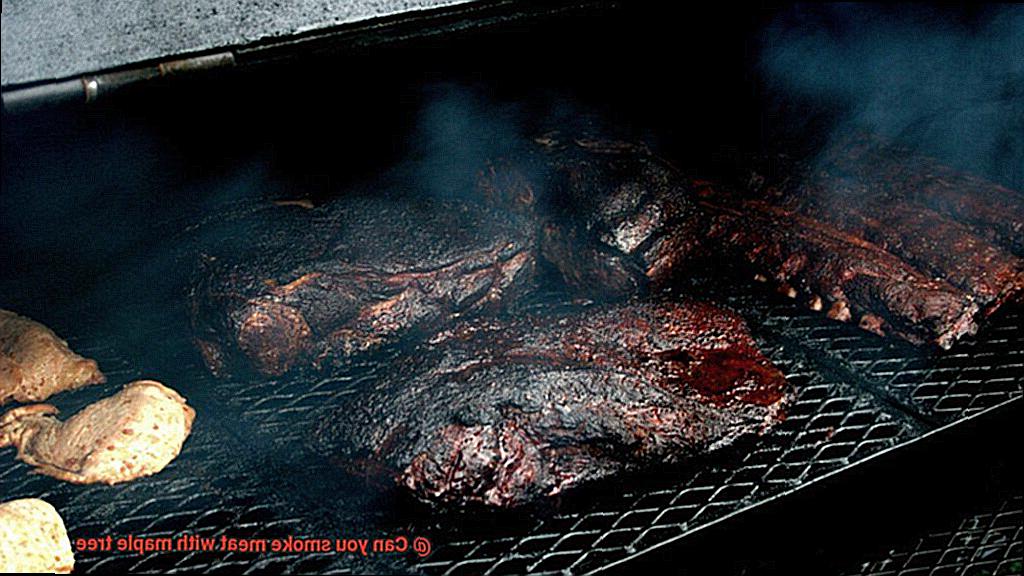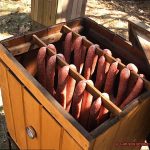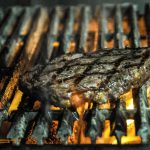Picture this: you’re at a backyard barbecue, surrounded by the mouthwatering aroma of smoked meat. You take a bite of your perfectly cooked brisket and savor the smoky, sweet flavor that lingers on your tongue. But what’s the secret to achieving that delectable taste? The type of wood you use for smoking can make all the difference. Enter maple tree wood – a popular choice among pitmasters for its rich and complex flavors. So, can you smoke meat with maple tree? Let’s find out.
Maple wood boasts a unique flavor profile that adds a touch of sweetness to your meat. We all know how delicious maple syrup is, but did you know that the wood itself can infuse similar flavors into your food? Its delicate yet mildly sweet taste pairs well with beef, pork, poultry, and even seafood – making it a versatile option for any kind of meat lover out there.
But here’s the burning question: is maple wood strong enough to smoke meat? And will it burn long enough to provide adequate smoke? Fear not – in this post, we’ll delve into the different types of maple wood and their benefits when used for smoking meat. We’ll also share tips on how to use maple wood for smoking, which cuts of meat work best with this flavorful option, and other tricks to achieve perfectly smoked maple-infused goodness.
So sit back, relax, and get ready to learn everything you need to know about smoking meat with maple tree. Trust us – your taste buds will thank you later.
Contents
What is Maple Wood?
Maple Wood: The Sweet and Subtle Choice for Smoking Meats
If you’re a meat lover, then you know that the magic is often in the smoke. And when it comes to smoking meats, there are a multitude of wood options to choose from. However, one wood that stands out for its unique flavor and aroma is maple wood.
Derived from the maple tree, which belongs to the Acer genus, maple wood is a hardwood that is known for its durability and beautiful grain patterns. But it’s also highly popular for smoking meats because of its sweet and subtle smoke profile.
When smoked, maple wood produces a delicate smoke that isn’t overpowering, making it an excellent choice for those who prefer a milder smoky flavor. Additionally, the light-colored smoke produced by maple wood won’t stain or discolor your meat.
But there’s more to maple wood than just its flavor profile. It’s also highly consistent when it comes to burning evenly and producing low amounts of ash, making it easy to clean up after smoking.
Of course, if you want to get the most out of your maple wood smoking experience, you’ll need to follow a few guidelines. First and foremost, it’s crucial to use dry and properly seasoned wood to avoid creating an overpowering taste that can ruin the meat’s flavor. Secondly, using the right amount of wood is essential; too much can result in an acrid taste while too little can lead to a lack of flavor. Finally, controlling temperature is key as maple wood burns quickly and can overcook your meat if not monitored carefully.
But as long as you follow these guidelines and pair maple wood with other woods like hickory or applewood, you’ll be able to create more complex and satisfying flavor profiles.
Benefits of Smoking Meat with Maple Wood
Maple wood is an excellent option for smoking meat due to its unique flavor and burning properties. When used as a smoking wood, it produces a sweet and subtle taste that complements the natural flavor of the meat without overpowering it. Additionally, maple wood burns slowly and evenly, making it perfect for low and slow cooking methods such as smoking.
One of the main benefits of smoking meat with maple wood is the distinct flavor it imparts. The sweetness of the wood adds a unique touch to the meat that cannot be replicated with other types of wood. Maple smoke is particularly outstanding with meats such as pork and chicken, which pair exceptionally well with its flavor profile. The subtle taste of maple also allows the natural taste of the meat to shine through, making it an excellent choice for those who want to enhance their meat’s flavor without overpowering it.
Another advantage of using maple wood for smoking is its burning properties. Maple wood burns slowly and evenly, ensuring that the meat cooks evenly throughout the smoking process. This makes it ideal for low and slow cooking methods that require a consistent temperature to achieve desirable results. Furthermore, since maple wood produces less ash than other types of wood, it is easier to clean up after use.
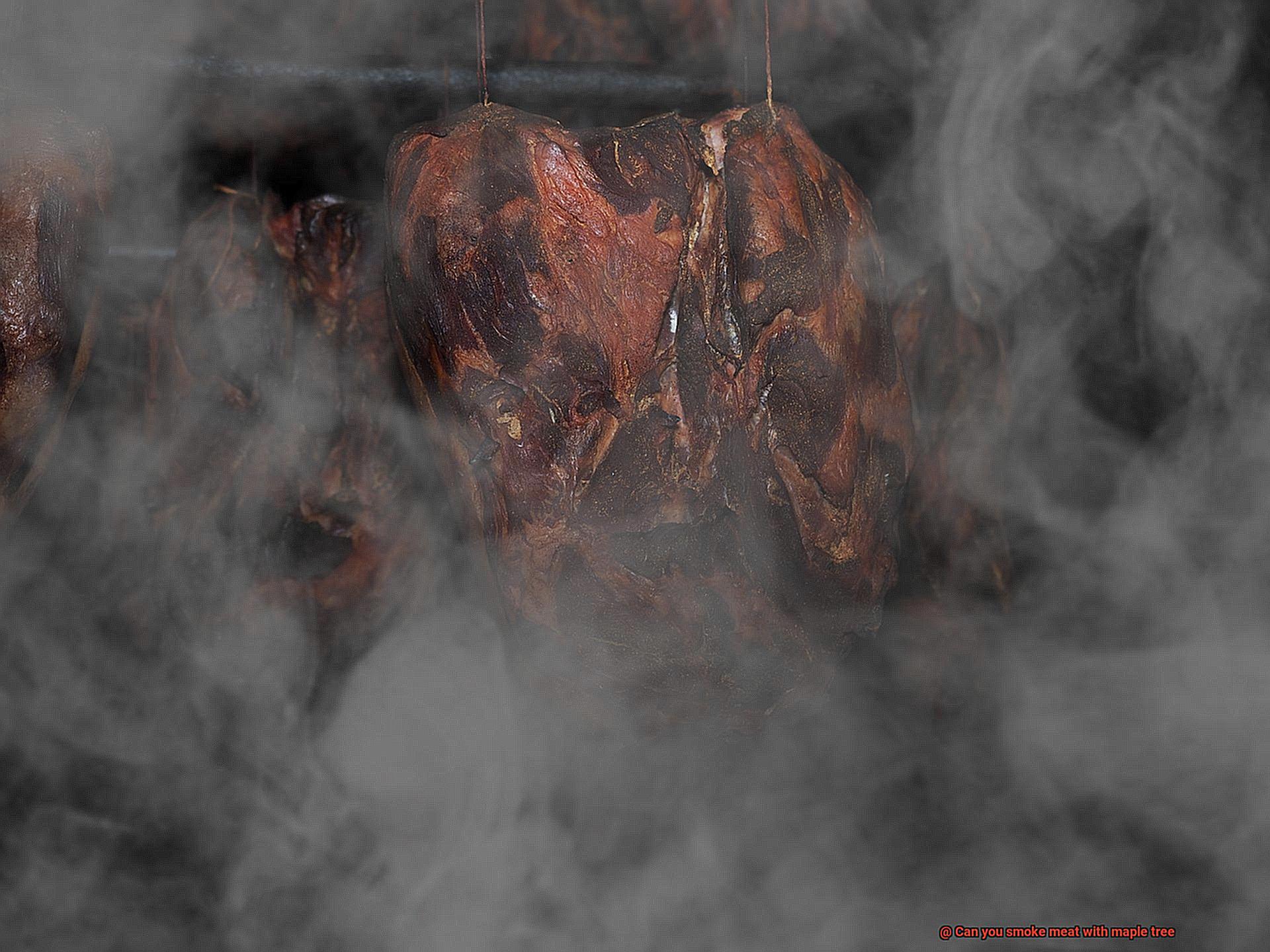
In addition to its flavor and burning properties, maple wood is also a healthier option compared to other types of wood. It contains fewer toxins and chemicals than some hardwoods, producing less harmful smoke when burned. This makes it a safer and healthier choice for those who are health-conscious.
Tips for Using Maple Wood for Smoking
Maple wood has a sweet and mild flavor that pairs perfectly with pork, poultry, and seafood. To make the most of your experience, here are five tips for using maple wood for smoking:
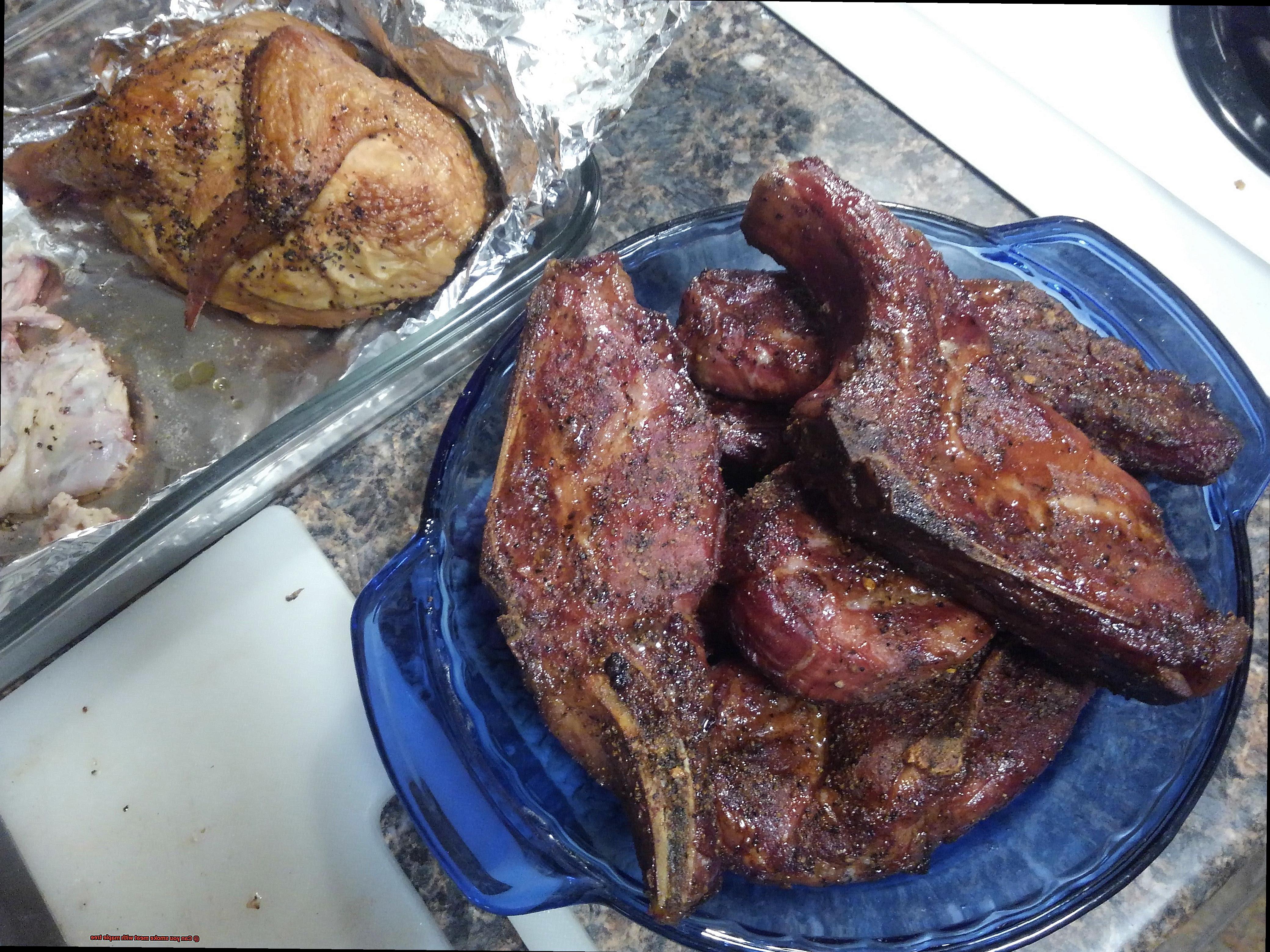
Use properly seasoned wood
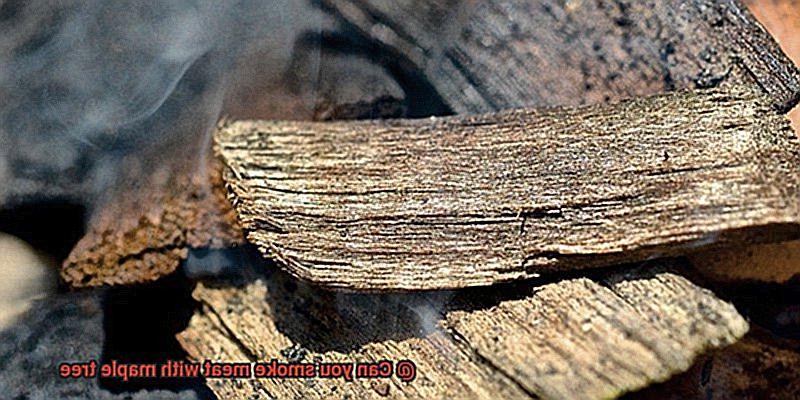
When selecting maple wood for smoking, it’s essential to use only dry and seasoned wood. Wet or green wood can produce a bitter taste and inconsistent burn, negatively impacting the flavor of your meat. It’s best to let the wood dry for at least six months before using it.
Soak the wood
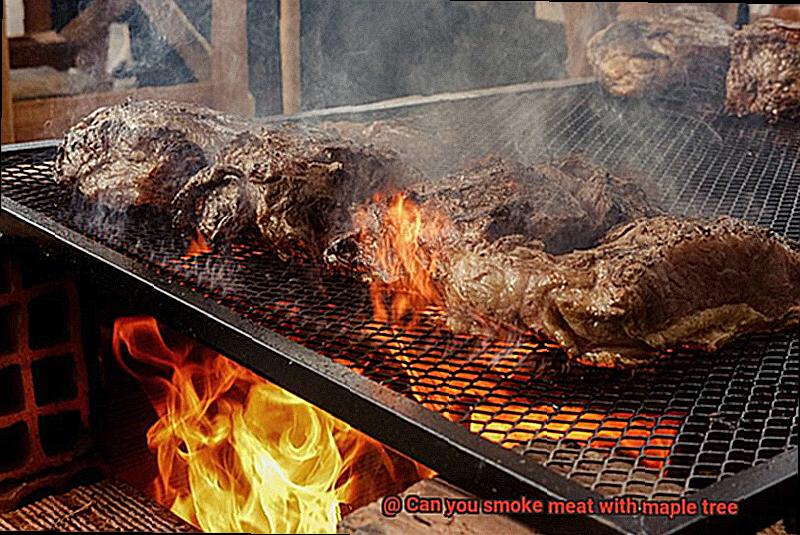
Before using the maple wood, soak it in water for at least an hour. This will help prevent the wood from burning too quickly and create a more even smoke. You can also experiment with soaking the wood in other liquids like beer or fruit juice to add an extra layer of flavor.
Opt for smaller wood pieces
When using maple wood, it’s better to use small pieces of wood rather than large logs. This allows for better control of the smoke and prevents the meat from being overpowered by too much smoke flavor. It’s recommended to use chunks or chips instead of logs.
Control the temperature
To ensure optimal smoking, it’s important to control the temperature of your smoker or grill when using maple wood. Keep the temperature around 225-250 degrees Fahrenheit, which is ideal for smoking meat over a longer period.
Experiment with other woods
While maple wood is an excellent choice for smoking meat, don’t be afraid to experiment with other types of wood as well. Hickory, oak, and mesquite are just a few other woods that can be used to add unique flavors to your smoked meats.
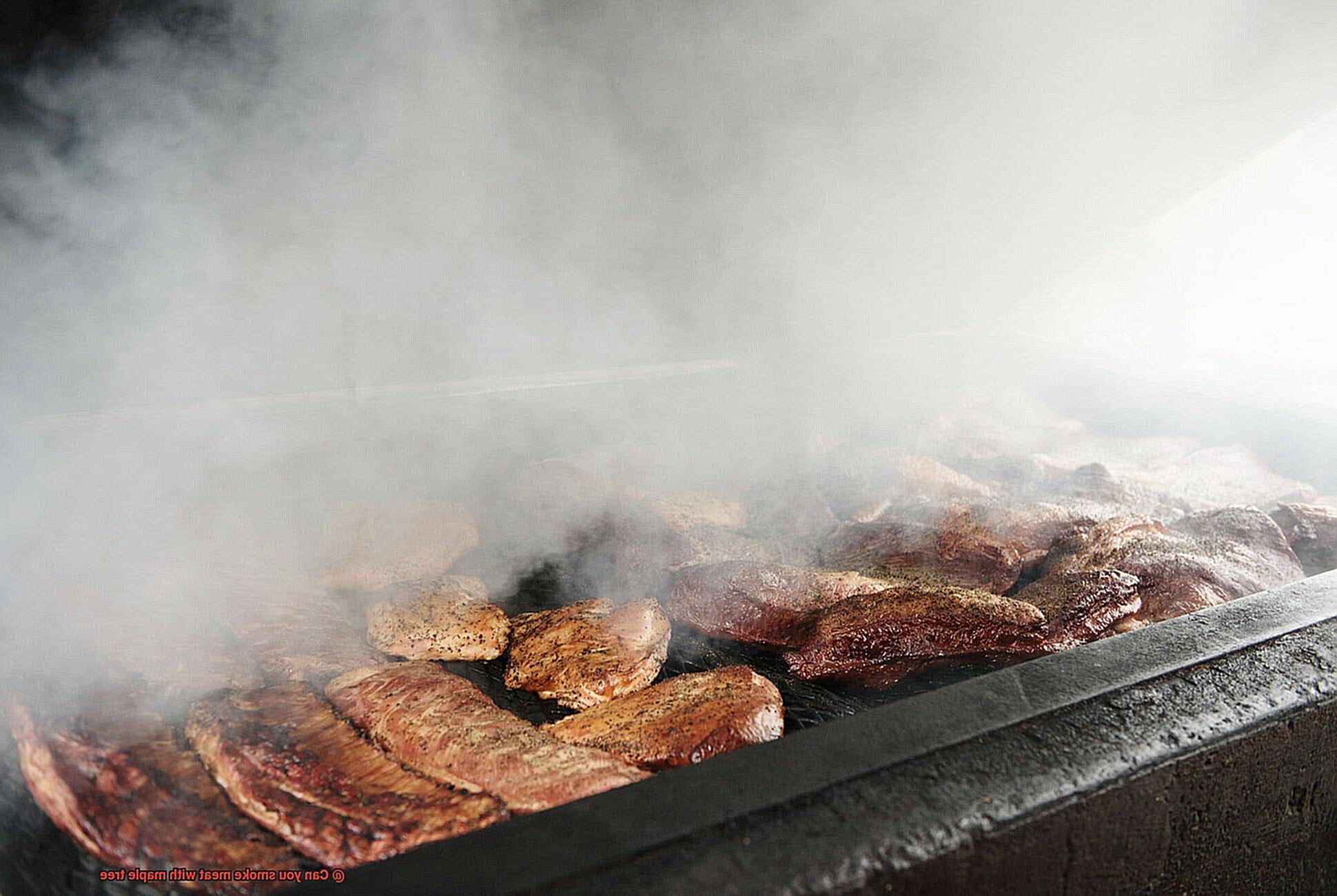
Drying and Seasoning Maple Wood
If you’re planning on using maple wood as a smoking wood, it’s important to know how to properly dry and season it for optimal use. Here are some expert tips to help you get the most out of your maple wood.
First and foremost, selecting the right type of maple wood is crucial. Sugar maple, with its sweet flavor and high density, is often the preferred choice for smoking. Once you have your wood selected, make sure to cut it into small pieces and split it into manageable sizes. This will promote more efficient drying and seasoning.
The next step is drying your wood. Properly drying your maple wood involves stacking it in a dry, well-ventilated area with plenty of airflow. Avoid stacking it too tightly, as this can prevent proper drying. Be patient and let your wood dry for at least six months, although some experts recommend up to a year. Trust us, the wait will be worth it.
After your maple wood has been dried, it’s time to season it. Seasoning involves exposing the wood to higher temperatures in order to remove any remaining moisture and improve its combustion properties. One effective method is to place the wood in a smoker or grill and heat it at a low temperature for several hours. This not only removes any remaining moisture but also infuses the wood with a smoky flavor that enhances the taste of meats cooked with it.
Controlling the Amount of Maple Wood Used
Smoking meat is an art form, and mastering the use of wood is crucial to creating the perfect flavor profile. But when it comes to using maple wood, controlling the amount used is just as important as the type of wood selected.
To begin, start with dry maple wood that has been properly seasoned. Green or wet wood will produce too much smoke, resulting in a bitter taste. Ensure your wood has been dried for at least six months in a well-ventilated area before using it.
Next, consider using a combination of hardwoods and fruitwoods to create a balanced and flavorful smoke profile. Maple pairs well with applewood, cherrywood, and hickory wood. Each type of wood will contribute its unique flavor to the meat, creating a harmonious blend of tastes.
For even more control over the amount of smoke produced, opt for wood chunks over chips. Wood chunks burn slower and produce less smoke than chips, allowing for more precise control over the amount of smoke produced.
Monitoring the temperature of your smoker is also essential in controlling the amount of maple wood used. If your smoker is running hot, use less wood to prevent over-smoking. On the other hand, if your smoker is running too cool, add more wood to maintain a consistent level of smoke.
Maintaining the Temperature When Smoking
When it comes to smoking meat, maintaining the temperature is crucial for ensuring that it cooks evenly and has a juicy and tender finish. However, when using maple wood, things can get a bit tricky since it burns hotter and faster than other types of wood. But fear not, because we’ve got some tips to help you maintain the temperature and achieve delicious results when smoking with maple wood.
Firstly, using a digital thermometer is an essential tool for any smoker. It allows you to monitor the internal temperature of the meat and the smoker’s temperature. By keeping an eye on these temperatures, you will be able to make adjustments as needed to ensure that the meat cooks evenly and does not dry out.
Secondly, using smaller pieces of wood is another way to help maintain the temperature. Maple wood burns hotter and faster than other types of wood, so using smaller pieces will help prevent the smoker from overheating. It will also help the wood burn more slowly, giving you better control over the cooking process.
Lastly, smoking meat with maple wood requires more attention than other types of wood. You may need to add more wood chips or adjust the temperature settings more frequently to ensure that the meat cooks properly. But don’t worry, with some practice and patience, you can achieve mouth-watering results.
Common Mistakes to Avoid when Smoking Meat with Maple Wood
Before you get started, it’s essential to know the common mistakes that can ruin your meat and leave you with unsatisfactory results. As an expert in smoking meat with maple wood, I’m here to share some tips to help you avoid these pitfalls and impress your guests with tender, juicy, and flavorful smoked meat.
One of the most significant mistakes is using green or unseasoned maple wood. The high moisture content in unseasoned wood can lead to inconsistent temperature and smoke output, resulting in subpar meat. Therefore, ensure that you use properly seasoned wood for the best results.
Another common mistake is over-smoking the meat. Maple wood has a sweet and delicate flavor that enhances the natural taste of the meat. Over-smoking can cause a bitter taste and ruin the flavor of the meat. Therefore, use the right amount of wood and time to achieve that perfect balance of smoky goodness.
Controlling the heat is critical when smoking meat with maple wood. Since it burns at a lower temperature than other woods, monitor the heat closely and adjust it as needed. Too high of a temperature can lead to dry or burned meat, so stay vigilant.
Lastly, resist the urge to use too much wood. Using an excessive amount can result in an overpowering smoke flavor that masks the natural taste of the meat. Use just enough for the size of your meat to achieve that perfect smoky flavor without going overboard.
He-Nw5-LMrE” >
Conclusion
In conclusion, smoking meat with maple tree is not only possible but also a popular choice among pitmasters. Its unique flavor profile adds a touch of sweetness to your meat without overpowering it, making it a versatile option for any kind of meat lover out there. Whether you’re smoking beef, pork, poultry, or even seafood, maple wood is an excellent option that won’t disappoint.
But what makes maple wood so special? Its delicate yet mildly sweet taste complements the natural flavor of the meat perfectly. When used as a smoking wood, it produces a sweet and subtle taste that enhances the overall flavor profile of your dish. Additionally, its slow and even burn rate makes it perfect for low and slow cooking methods such as smoking.
However, to ensure that you get the most out of your experience when using maple wood for smoking, there are some essential guidelines to follow. Firstly, make sure you use dry and properly seasoned wood to avoid creating an overpowering taste that can ruin the meat’s flavor. Secondly, using the right amount of wood is crucial; too much can result in an acrid taste while too little can lead to a lack of flavor. Finally, controlling temperature is key as maple wood burns quickly and can overcook your meat if not monitored carefully.
By following these simple guidelines and pairing maple wood with other woods like hickory or applewood, you’ll be able to create more complex and satisfying flavor profiles that will leave your guests asking for more.

